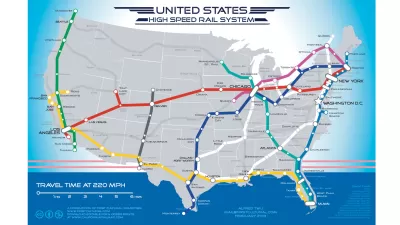A $226 million contract to build 32 higher speed diesel locomotives, capable of reaching 125 mph, was awarded to the team of the German conglomerate, Siemens AG and Indiana-based engine maker Cummins, Inc over Peoria, Ill. based Caterpillar, Inc.

What made the award to Siemens AG (teamed with Cummins) particularly remarkable was that it was done by the Illinois Department of Transportation on behalf of all five states that are developing high-speed intercity rail routes with Amtrak: California, Washington, Michigan and Missouri, and Illinois.
"Caterpillar's bid featured a locomotive with a 20-cylinder engine, but was priced higher at about $8.1 million per unit, or $260 million," writes Bob Tita. Caterpillar had protested that the $7 million Siemens locomotive "which would be powered with a 16-cylinder diesel engine, couldn't meet the 125 mph requirement, unless it was traveling downhill," adds Tita. IDOT didn't agree.
The locomotives will be purchased with federal stimulus funds provided by the 2009 Recovery Act for the the five states that are developing high-speed intercity rail routes with Amtrak.
As the winning bidder, Siemens also received the right to supply up to 225 additional locomotives, provided state or federal funding is available in the coming years. The additional orders could be worth at least $1.5 billion for Siemens, based on its initial price of $7 million per locomotive.
While Tita and IDOT refer to the 125 MPH, diesel-powered service as high speed rail, it is also termed "higher" speed to distinguish it from 150+ MPH electric service provided by Acela Express on the Northeast Corridor as well as in nations throughout Europe and Asia.
The contract is in addition to the "$500 million on new (electric) locomotives for the Northeast Corridor" awarded to Siemens that we posted last July.
FULL STORY: Caterpillar Loses High-Speed Train Contract

Alabama: Trump Terminates Settlements for Black Communities Harmed By Raw Sewage
Trump deemed the landmark civil rights agreement “illegal DEI and environmental justice policy.”

Study: Maui’s Plan to Convert Vacation Rentals to Long-Term Housing Could Cause Nearly $1 Billion Economic Loss
The plan would reduce visitor accommodation by 25% resulting in 1,900 jobs lost.

Why Should We Subsidize Public Transportation?
Many public transit agencies face financial stress due to rising costs, declining fare revenue, and declining subsidies. Transit advocates must provide a strong business case for increasing public transit funding.

Paris Bike Boom Leads to Steep Drop in Air Pollution
The French city’s air quality has improved dramatically in the past 20 years, coinciding with a growth in cycling.

Why Housing Costs More to Build in California Than in Texas
Hard costs like labor and materials combined with ‘soft’ costs such as permitting make building in the San Francisco Bay Area almost three times as costly as in Texas cities.

San Diego County Sees a Rise in Urban Coyotes
San Diego County experiences a rise in urban coyotes, as sightings become prevalent throughout its urban neighbourhoods and surrounding areas.
Urban Design for Planners 1: Software Tools
This six-course series explores essential urban design concepts using open source software and equips planners with the tools they need to participate fully in the urban design process.
Planning for Universal Design
Learn the tools for implementing Universal Design in planning regulations.
Smith Gee Studio
Alamo Area Metropolitan Planning Organization
City of Santa Clarita
Institute for Housing and Urban Development Studies (IHS)
City of Grandview
Harvard GSD Executive Education
Toledo-Lucas County Plan Commissions
Salt Lake City
NYU Wagner Graduate School of Public Service


























